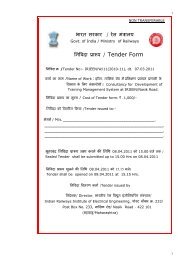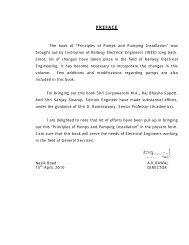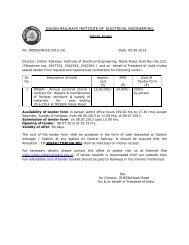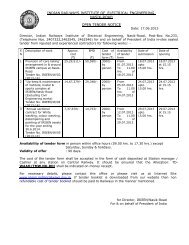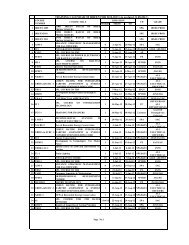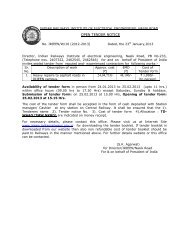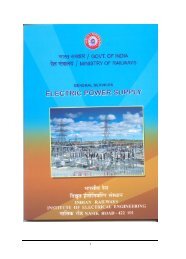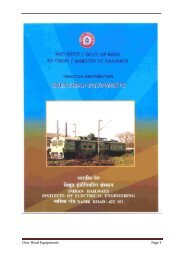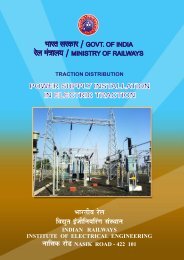Traction Rolling Stock - Indian Railways Institute of Electrical ...
Traction Rolling Stock - Indian Railways Institute of Electrical ...
Traction Rolling Stock - Indian Railways Institute of Electrical ...
Create successful ePaper yourself
Turn your PDF publications into a flip-book with our unique Google optimized e-Paper software.
akes.<br />
e) When Driver makes an emergency application both EP and Auto brakes apply.<br />
7.3.3 Main components<br />
The main components <strong>of</strong> the equipment are as under -<br />
7.3.3.1 A main reservoir system consisting <strong>of</strong> a compressor in each motor coach feeding into main<br />
reservoirs on motor coaches and supplementary reservoirs on trailer coaches inter-connected<br />
from end to end <strong>of</strong> the train by a main reservoir pipe with flexible couplings at ends <strong>of</strong> coaches.<br />
The main reservoir is maintained at a pressure <strong>of</strong><br />
5.8 to 7.0 kg/cm² by means <strong>of</strong><br />
pressure governors controlling each compressor. All the compressors in train are synchronized to<br />
start and stop together.<br />
7.3.3.2 A brake pipe from end to end <strong>of</strong> the train with flexible inter-connections between coaches.<br />
The pressure in this pipe is maintained at 4.57 kg/cm ² to keep the automatic brakes released.<br />
7.3.3.3 A brake unit in each coach consisting <strong>of</strong> the control valves for control <strong>of</strong> EP and auto<br />
brakes.<br />
7.3.3.4 The brake cylinders on each bogie with automatic slack-adjusters and associated brake<br />
rigging. Usually the number <strong>of</strong> brake cylinders is four per bogie on motor coaches and two per<br />
bogie on trailer coaches.<br />
7.3.3.5 A brake controller in each driving cab. The controller in the driving cab in use is made<br />
operative by means <strong>of</strong> an isolating valve switch operated by Driver's key.<br />
7.3.3.6 A brake application relay in each driving cab, the one in the operative cab responding to<br />
the operation <strong>of</strong> the brake controller to control the supply to the brake control train wires carried<br />
along with the other control wires in the inter-vehicular couplers.<br />
7.3.3.7 Five train wires, viz EP supply wire, brake application holding train wire, brake indication<br />
wire and EP return wire.<br />
7.3.3.8 A warning system to indicate to the Driver if EP brakes have applied and to warn him if a<br />
failure takes place.<br />
7.3.3.9 A pilot valve and emergency valve to operate the brakes if the dead-man's device is<br />
released.<br />
7.3.3.10 Isolating cocks, pressure gauges and control switches.<br />
7.3.3.11 Release valves for manual release <strong>of</strong> brakes in individual bogies.<br />
7.3.4 Brake equipment in coaches<br />
Each coach has an EP brake unit which houses the control valves for both EP and autobrakes.<br />
The 'pipe-bracket' arrangement is used where by the valves are bolted on to a casting




